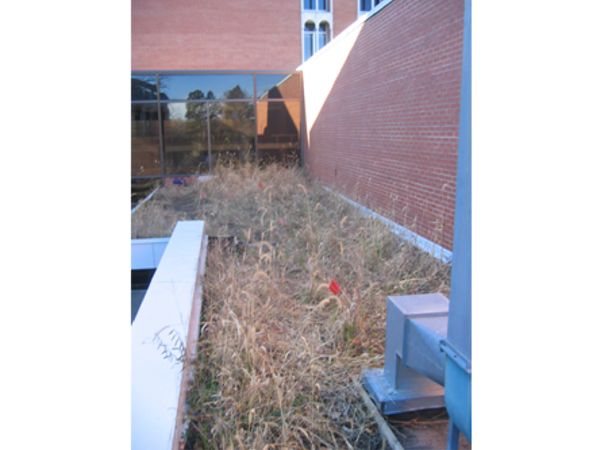
Additional Resources
Visit the new Carlton College Green Roof Project website here. Download Sonja Mae Langton-Yanowitz’s 27-page PDF here. Read the complete July 2005 Greenroofs.com Student Guest Feature Article by David Holman, Jason Lord, Jake Gold, and Andrew Kaplan of Carleton College here. See the students’ PDF of The Carleton Green Roof Project which also includes R-value testing information here.
On May 18, 2005 five Carleton College students completed building the first green roof to test 78 varieties of prairie plants native to Minnesota for their viability to the green roofing industry. Construction began on Friday, May 13 and the roof was finished and planted by Thursday, May 19. In the three weeks following the construction thousands of seeds germinated and the rootstocks seemed to be taking hold and growing. This 666 sq ft roof on part of the Olin Science Building at Carleton College is also the first student-designed and built green roof in Minnesota. The fall of 2004 was spent studying green roof design and planning where green roofs could be made at Carleton.The roof will provide structural, functional, environmental and aesthetic benefits to the building. The project will provide plant growth data, water monitoring and temperature data that will be used for further roof construction at Carleton and by green roof contractors. The roof can be easily viewed from the glass breezeway connecting the Olin and Mudd Science Buildings at Carleton College.
The drainage layer beneath the growing media is a DBR-50 Rootbloc product manufactured and generously donated by American Wick Drain. This drainage layer provides a grid of small plastic cups to retain water while any overflow drains away. The soil substrate consists of two layers: the bottom layer is a 4″ mix of 36.5% Perlite, 36.5% Vermiculite, 12% Clay Particles (a product called Turface), and 15% compost from Carleton’s yard waste pile. This bottom layer is designed to be extremely lightweight, water absorptive, and inorganic. The top layer 2″ of pure compost is then slightly mixed into the bottom layer to create a heavier, more organic top layer for seed germination and prevention of soil loss via wind. The 6″ mixture weighs 16.1 lbs/sq ft dry and 24.9 lbs/sq ft saturated. This unusually organic soil mixture was used to provide more lush plant growth. This compares favorably to the existing ballast, weighing 11 lbs/sf. The goal in this project was to design a green roof using as many native prairie plants as possible. The students used a large seed mixture of hardy prairie plants from this area and chose species that they thought would best survive thin the hot, dry and shallow soil environment. They planted: 54 species of prairie forbs, three types of shrub/vine species, 19 species of grasses, sedges, and rushes, and a cover crop of oats was seeded.Sonja Mae Langton-Yanowitz, a senior biology major, became involved with the project because of her interest in plant identification and in the fall of 2005 was the primary leader of an extensive plant survey. She writes “Our research interests are three-fold: We are curious about 1) the additional insulation value (R-value) that a green roof provides to an existing roof, 2) how a green roof affects water-runoff quality, and 3) how the unique environment of a green roof affects the colonization and survival of prairie plants native to Minnesota. This article addresses question number three and presents the findings of our first plant survey, which was conducted during the fall of 2005.”
 Greenroofs.comConnecting the Planet + Living Architecture
Greenroofs.comConnecting the Planet + Living Architecture





